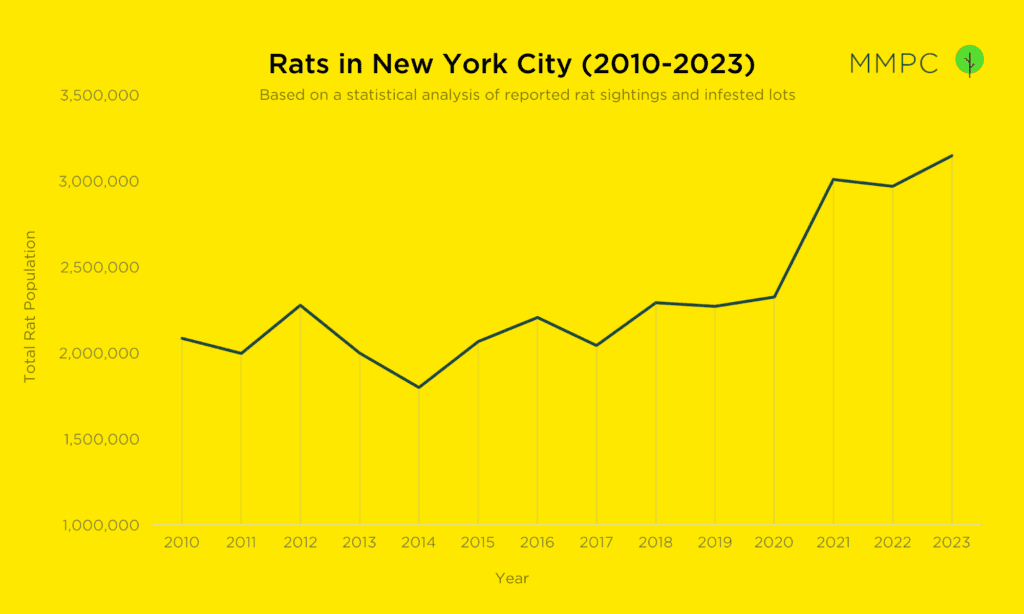There Are 3 Million Rats in NYC, a 50% Increase Since 2010
By:
Updated:


MMPC conducted a statistical analysis on city-wide rat sightings using a method proposed by Jonathan Auerbach in 2014. Based on our findings, there are now as many as 3 million rats in New York City.
How Many Rats Are in NYC?
New York City’s rat population has been a topic of interest for years, especially following the COVID-19 pandemic.
Counting every rat is impossible, but in 2014, a statistician named Jonathan Auerbach estimated that there were as many as 2 million living in the Big Apple.1 He reached this figure using 311 rat sighting reports from 2010 and 2011 to estimate the number of rat-infested lots in the city.
More than a decade later, we applied the same methodology using recent data. Our findings show that there are now as many as 3 million rats in New York City.
Background – 2 Million Rats in 2010
In the field of ecology, scientists estimate large populations of wild animals using the capture-recapture method, also known as mark and recapture. The process involves:
- Capturing a sample of animals, marking them, and releasing them.
- Later, after the marked animals have integrated back into the wild population, capturing a second sample and counting how many marked animals are recaptured.
- Using the ratio of marked to unmarked animals in the second group to estimate the total population.
Auerbach adapted this method using 311 rat sighting reports across two discrete sample periods (the first 6 months of 2010 and the first 6 months of 2011) in lieu of physically capturing and recapturing rats. His approach:
- City lots with rat sightings in the first sample period (S1) are considered “captured.”
- City lots with rat sightings in both the first and second sample periods (S1 and S2) are considered “recaptured” (R).
- He assumed all rat-inhabited lots had an equal chance of being reported and that the total number of rat-inhabited lots (T) remained stable.
- The total number of rat-inhabited lots (T) within a given area can be estimated using the formula: T = S1 × S2 ÷ R
Auerbach found 45,000 (±3,000) rat-inhabited lots in NYC, about 4.75% of all lots. Assuming an average colony size of 50 rats per lot, he estimated 2 million rats (±150,000) in 2010.
Methods – Estimating NYC’s Rat Population in 2023
To understand how NYC’s rat population has changed, we replicated Auerbach’s method using 311 data from 2023 and 2024:
- 1st Sample Period (S1): January 1, 2023 – June 30, 2023
- 2nd Sample period (S2): January 1, 2024 – June 30, 2024
- Data Source: Rat Sightings based on 311 Service Requests from 2010 to Present2
City lots with rat sightings in both sample periods were considered “recaptured” (R) and the total number of rat-inhabited lots (T) was estimated using the formula: T = S1 × S2 ÷ R
Unlike Auerbach, we applied this method at the borough level instead of the neighborhood level due to data limitations. Some areas had zero “recaptured” lots, making neighborhood-level estimates unreliable. Our borough-level analysis using Auerbach’s original data from 2010–2011 yielded 41,735 (±3,379) rat-inhabited lots, which is close to his original estimate of 45,000 (±3,000).
Applying the same method to data from 2023–2024, we found 62,969 (±2,240) rat-inhabited lots, a significant increase.
In the final step, Auerbach assumed each infested lot housed 50 rats. Based on our experience performing rat control throughout the city, this is likely overestimated. NYC lots are small, limiting colony sizes. Most infested lots contain 1–3 active burrows, each supporting 5–15 rats. However, assuming 50 rats per lot still provides a reasonable estimate of the upper bound for the city’s rat population.
Results – 3 Million Rats in 2023
Our statistical analysis showed 62,969 (±2,240) rat-inhabited lots in 2023, which is 7% of all lots in the city. If each supports up to 50 rats, that means there are 3 million rats in New York City.
That’s 1 million more rats (a 51% increase) since 2010. Queens had the biggest uptick in rat population (+59%), followed by Manhattan (+58%) and Brooklyn (+55%).
| Infested Lots (Jan – Jun 2023) | Infested Lots (Jan – Jun 2024) | Marked Lots (“Recaptured”) | Total Estimated Infested Lots | Total Estimated Rat Population | |
| Brooklyn | 3,397 | 3,414 | 508 | 22,829 | 1,141,472 |
| Manhattan | 2,028 | 1,732 | 359 | 9,784 | 489,206 |
| Queens | 1,486 | 1,578 | 115 | 20,391 | 1,019,525 |
| The Bronx | 1,105 | 1,191 | 212 | 6,208 | 310,390 |
| Staten Island | 221 | 238 | 14 | 3,757 | 187,850 |
| Total | 62,969 | 3,148,443 |
Applying this method across 2011–2023 reveals how NYC’s rat population has changed. It also highlights impacts from major events like Hurricane Sandy (2012) and the COVID-19 pandemic (2020–2021).

Conclusion
New York City has one of the largest populations of brown rats (Rattus norvegicus) in the US. These large, aggressive rodents infest buildings, damage property, and spread disease. And unfortunately for New Yorkers, they’re a difficult problem to solve.
Rats are smart and highly adaptable. They quickly learn to avoid traps and baits. And NYC’s urban landscape provides endless food sources—overflowing trash bins, outdoor dining, and street waste—plus plenty of hiding places in subways, sewers, and construction zones.
Need expert help? MMPC has 30+ years of experience in rat control and exclusion. We offer discreet, effective solutions to keep your property rodent-free.

About the Author
References
- Jonathan Auerbach, Does New York City Really have as Many Rats as People?, Significance, Volume 11, Issue 4, October 2014, Pages 22–27, https://doi.org/10.1111/j.1740-9713.2014.00764.x ↩︎
- 311 Service Requests from 2010 to Present | NYC Open Data. (n.d.). NYC Open Data. https://nycopendata.socrata.com/Social-Services/311-Service-Requests-from-2010-to-Present/erm2-nwe9/data ↩︎
